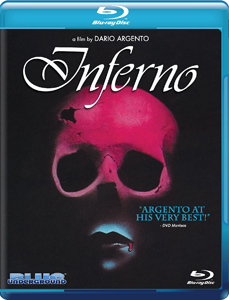After being mesmerized by “Suspiria” (1977), I continued my journey through this world of secret witchcraft with the 2018 remake. Woopsie. After saying goodbye to those 3 hours I’ll never get back, I learned Dario Argento himself continued the series with “Inferno” (1980). It’s the second of the Three Mothers Trilogy, which concludes with “Mother of Tears” (2007).
Argento – with uncredited assistance from his mentor Mario Bava, since he was ill through much of the shoot — largely remakes “Suspiria” in “Inferno.” Instead of a German ballet studio, we focus on a massive apartment building in New York City (although it’s lensed in Italy). It’s home to Rose (Irene Miracle), whose curiosity about the Three Mothers mythology might not serve her well. It’s forebodingly shot from below, with Rose’s visiting brother, music student Mark (Leigh McCloskey), gazing in awe at the edifice.
The colors and score are more subdued this time, although style is still Argento’s main concern. The hallways are a dark red, ideal for a vampire’s lair. While Goblin does not return for this sequel, composer Keith Emerson continues in its spirit.

“Inferno” (1980)
Director: Dario Argento
Writers: Dario Argento (screenplay, story); Dardano Sacchetti (screenplay); Thomas De Quincey, Daria Nicolodi (book)
Stars: Leigh McCloskey, Irene Miracle, Eleonora Giorgi
Sometimes he uses walls of synth, sometimes a tinkly melody, and sometimes all sound is stripped from the track. Most memorably, the intense/action scenes are bolstered by Emerson’s gothic mood rock piece “Mater Tenebrarum,” with vocalist Linda Lee repeating the Three Mothers’ names – Suspiriorum and Lachrymarum are the other two. With a lyric change, this could’ve been Rick Santorum’s campaign song in 2012, perhaps accompanied by flames, as in “Inferno’s” closing credits.
(Spoilers about the world-building and plot follow.)
Presumably, Suspiriorum is the one dispatched in “Suspiria,” but the villain in “Inferno” refers to herself as “The Three Mothers” (is this an Unholy Trinity of sorts?) and as “Death.” The only reasonable way to figure out the mythology through two entries is to do outside research. The web tells me both Mater Tenebrarum and Mater Lachyrmarum are in this movie, and Mater Suspiriorum indeed died in “Suspiria.” Maybe the third film delves into the details.
(End of spoilers.)
Cats, rats and dream logic
Along with a less in-your-face style, the other way “Inferno” falls short of “Suspiria” is that we aren’t following the magnetic Jessica Harper, but instead four serviceable audience surrogates caught up in this weirdness. Along with Mark and Rose, we have Mark’s school friend Sara (Eleonora Giorgi) back in Rome; and Elise (Daria Nicolodi), Rose’s friend whom Mark meets in the Big Apple building.
While reasonably engaging, “Inferno” progresses at a slow burn. It’s built upon horror set pieces. Though the movie is not incredibly scary, Argento proves himself a master of jump scares without lazily relying on sudden bursts of sound. Like a pair of hands will emerge from the dark background behind a skulking hero.

Argento also goes for dream states, and he doesn’t achieve the look of the subconscious, but certainly the gauzy logic/illogic is present. Rose investigates the basement of the bookshop – which abuts the apartment building — where she learned about the Three Mothers mythology. She drops a pendant into a pool of what you’d think would be standing pipe-leakage water, but it’s a portal to a sub-basement filled with clean water. Perhaps “A Nightmare on Elm Street” drew some inspiration.
The practical gore effects are top-shelf – though becoming more expected by 1980 than in earlier giallo films – and animal wrangling becomes a key part of “Inferno.” Those interested in cat symbolism will enjoy a deep dive after watching this film, and rats are also showcased in a sequence – although I’m more impressed by the gorgeous backdrop than the attack. Romano Albani captures a moonlit calmness amid this odd sewer runoff area amid NYC.
While “Inferno” is obviously a step down from “Suspiria” because it edges away from the totally immersive color-and-sound show and isn’t as successful in portraying a borderline nightmare world, one thing remains consistent: Argento provides an experience more so than a plot. Mostly, I’m fine with that.

